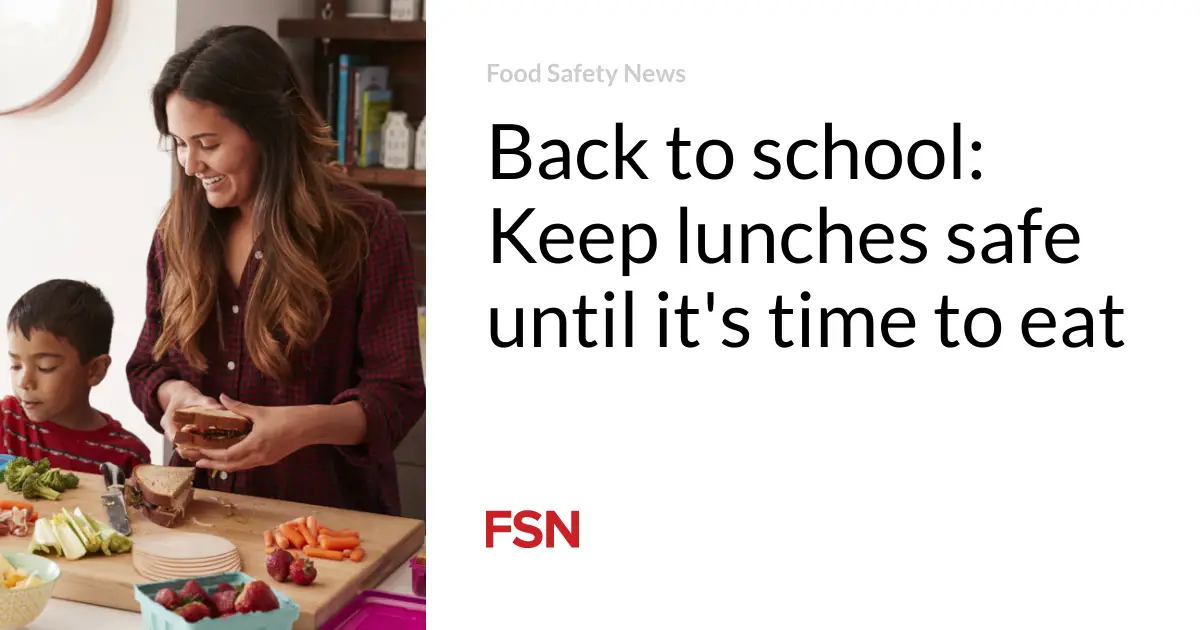
As the new school year approaches, parents are not only busy purchasing school supplies but also focusing on packing safe and nutritious lunches for their children. Ensuring that homemade lunches are kept at safe temperatures is crucial to preventing foodborne illnesses. The USDA Food Safety and Inspection Service (FSIS) provides essential tips on how to pack lunchboxes and “bag” lunches that keep food safe until it’s time to eat.
Lunchbox safety tips:
Cold lunches: Keep it chilled
The USDA recommends using a soft-sided lunch bag with at least two cold sources for cold lunches. “You can use two frozen gel packs, each no smaller than 5×3 inches, or combine a frozen gel pack with a frozen juice box or bottle of water,” says the USDA. Place cold sources on both the top and bottom of perishable food items to maintain a safe temperature. If the school has refrigeration available, store perishable items there upon arrival, leaving the lid or bag open to allow cold air to circulate.
Hot lunches: Maintain the heat
For hot lunches, an insulated container is a must. FSIS advises filling the container with boiling water, letting it stand for a few minutes, then emptying it before adding the hot food. “Keep the insulated container closed until lunchtime to ensure the food remains at a safe temperature of 140 degrees F,” the FSIS recommends.
Post-lunch safety
After lunch, it is important to discard all leftover food, used disposable packaging, and paper bags to prevent contamination. Do not reuse disposable packaging as it may harbor bacteria that could contaminate other foods.
Other safe options
Non-perishable items that do not require refrigeration include whole fruits and vegetables, hard cheese, canned meat and fish, chips, bread, crackers, jerky, jelly, mustard, and pickles. These items can be safely included in your child’s lunch without cold packs.
Baged lunches safety tips:
Millions of Americans bring “bag” lunches to school or work. It is crucial that these meals are prepared safely and kept at appropriate temperatures during transport and storage. Perishable items must be kept cold to prevent the growth of harmful bacteria, which multiply rapidly between 40 degrees F and 140 degrees F, known as the “Danger Zone.”
Begin with safe food
Always start with perishable food items, such as meat, poultry, and hard boiled eggs, that have been properly refrigerated. Transport these items home from the store as quickly as possible to keep them cold. Perishable foods should not be left at room temperature for more than two hours — one hour if the temperature is above ambient 90 degrees F.
Prepackaged combos, often packed for lunch, contain perishable foods such as luncheon meats, cheese, and cut fruit that must be kept refrigerated, even if they are cured or contain preservatives.
Keep everything clean
Before beginning to pack lunches, make sure to wash your hands with soap and warm water for 20 seconds. Wash cutting boards, dishes, utensils, and countertops with hot, soapy water after preparing each food item and before moving on to the next item. A solution of one tablespoon of unscented, liquid chlorine bleach in one gallon of water can be used to sanitize surfaces and utensils. Keep family pets away from kitchen counters to avoid contamination.
Avoid cross-contamination
Harmful bacteria can spread throughout the kitchen and onto cutting boards, utensils, and countertops. Always use a clean cutting board. When using a cutting board for food that will not be cooked, such as bread, lettuce, and tomatoes, be sure to wash the board after using it to cut raw meat and poultry. Consider using one cutting board for fresh produce and a separate one for meat and poultry.
Packing lunches
Pack just the amount of perishable food that can be eaten at lunchtime to avoid issues with storage or safety of leftovers.
It’s fine to prepare food the night before, but pack lunch bags right before leaving home. Freezing sandwiches helps them stay cold; however, for best quality, don’t freeze sandwiches containing mayonnaise, lettuce, or tomatoes. Add these ingredients later.
Insulated, soft-sided lunch boxes or bags are best for keeping food cold. Regardless of the type of lunch bag or box you use, pack at least two ice sources with perishable food.
Microwave Cooking/Reheating
When using a microwave oven to reheat lunches, cover food to hold in moisture and promote safe, even heating. Reheat leftovers to at least 165 degrees F, using a food thermometer to ensure a safe temperature has been reached before consuming the food. Cook frozen convenience meals according to package instructions.
For more information about food safety, contact the USDA Meat and Poultry Hotline at 1-888-MPHotline (1-888-674-6854), email MPHotline@usda.gov, or chat live at ask.usda.gov from 10 a.m. to 6 p.m. EDT, Monday through Friday, to reach a food safety specialist in English or Spanish.
(To sign up for a free subscription to Food Safety News, click here.)






